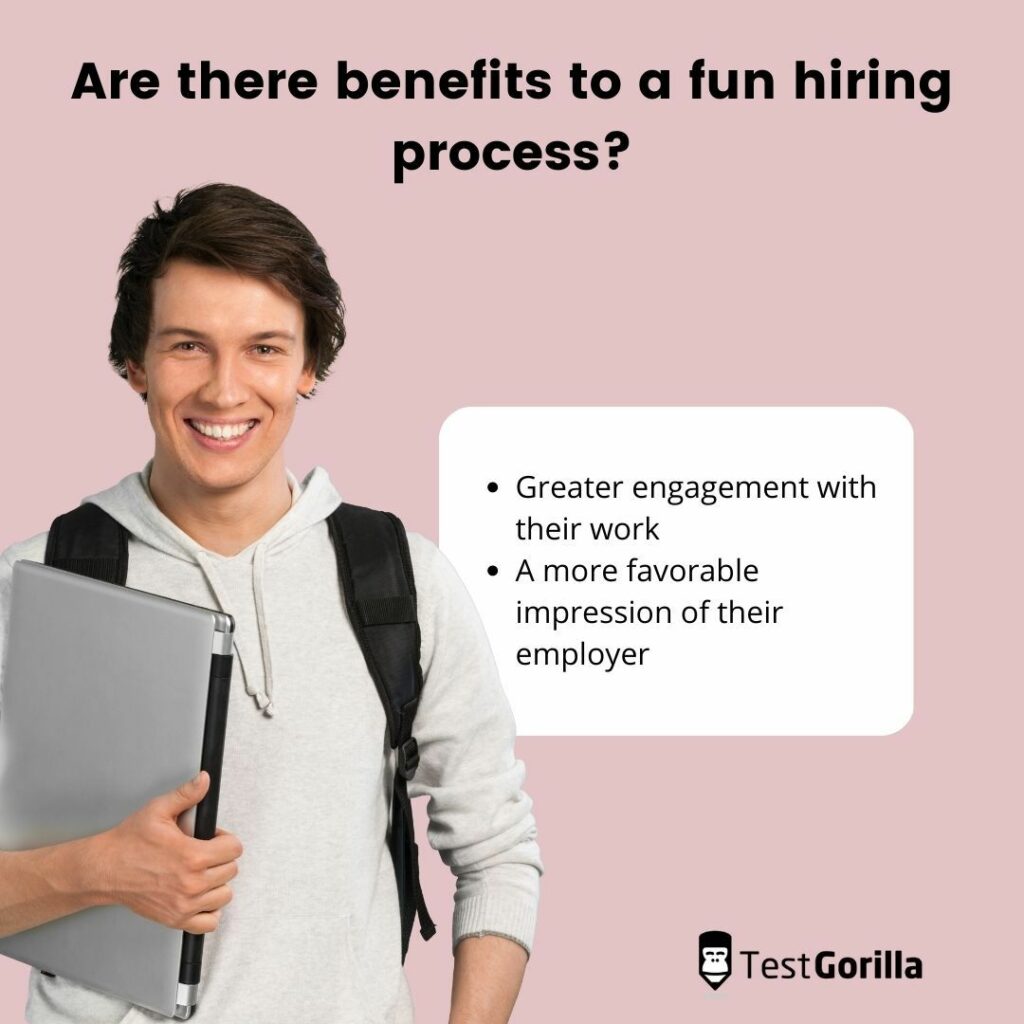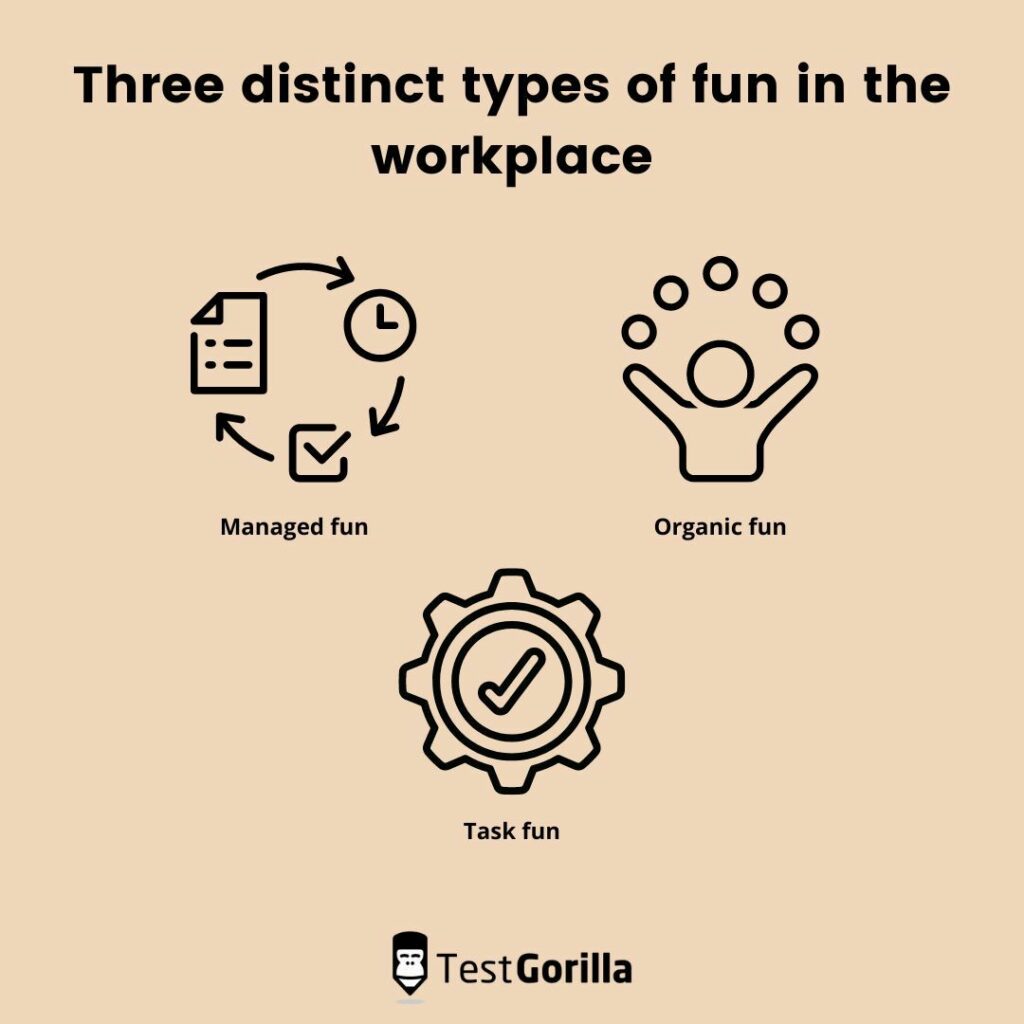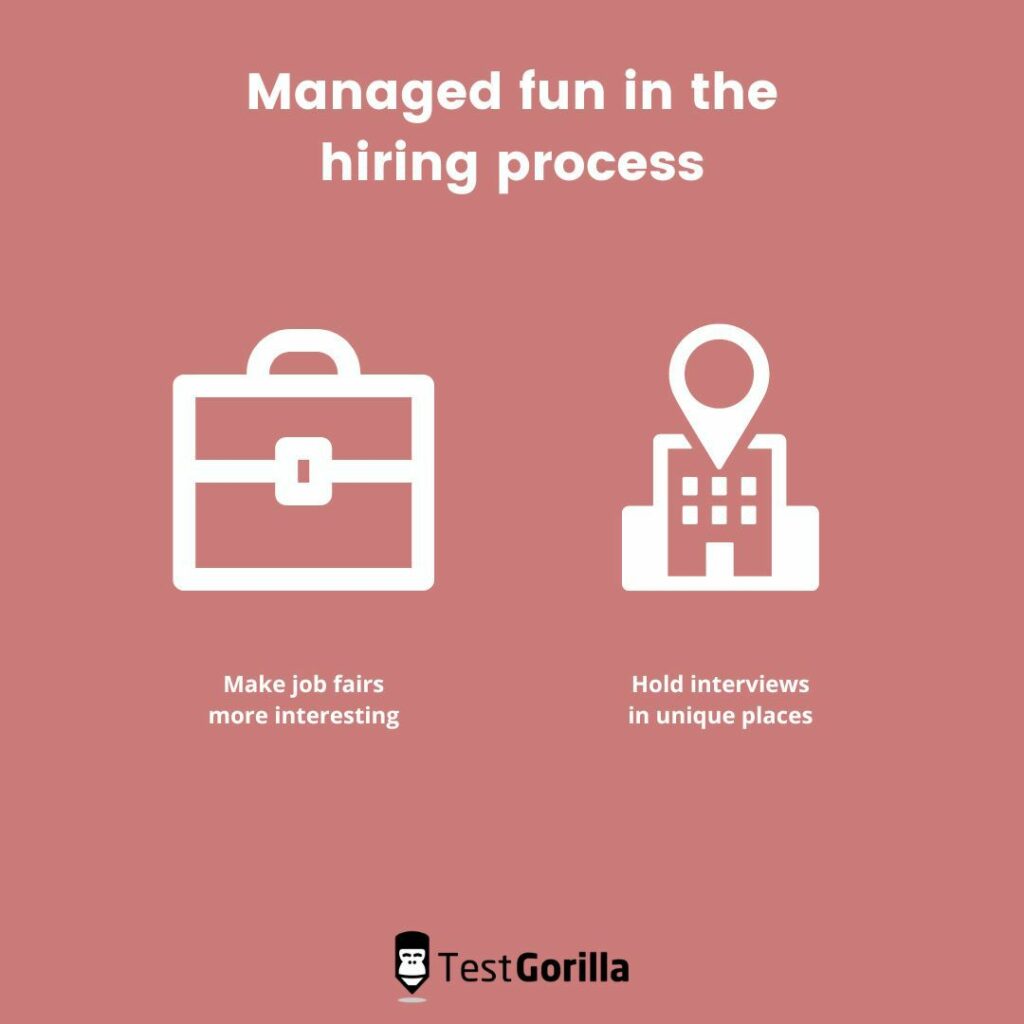The terms “fun” and “hiring process” aren’t typically used in the same sentence. Hiring is a high-stakes and high-pressure situation for job seekers and employers alike.
On the candidate side, failure to secure a job can result in anxiety and depression, while job seekers worry about providing for their families.[1] Likewise, organizations dealing with never-ending vacancies face morale issues because employees must work overtime to compensate.
These emotions make the typical hiring process feel more like a painstaking chore than anything else.
And the current job market certainly doesn’t help. Both candidates and employers have experienced a rise in professional ghosting,[2] or a lack of communication about whether a company is making an offer (and whether the candidate accepts).
Given these realities, we wondered: Can hiring be fun? And what are the benefits of having a fun process, if any?
After diving into the research, we discovered that hiring can not only be fun – there are even data-backed benefits to encouraging it. Incorporating fun into the hiring process facilitates a better experience for recruiters, human resource professionals, and job candidates alike.
We’re excited to share more about our findings, including the ways innovative companies are shifting the hiring paradigm away from the status quo to encourage fun – and how you can do the same.
Table of contents
Are there benefits to a fun hiring process?
Before we discuss whether hiring can be fun, we first need to establish whether or not it should be fun. After all, a job is a job, right?
According to researchers, not quite.
Individuals who enjoy their workplace have deeper levels of engagement with their organization than those who don’t.[3] A recent survey also found that 81% of employees who considered their organization a “great” place to work believed that their work environment was fun.
In other words, having fun in the workplace is not only possible, but it also leads employees to have:
Greater engagement with their work
A more favorable impression of their employer
Not coincidentally, these two outcomes of fun are also vital to recruiting the best professionals for your organization.
Maintaining engagement throughout a hiring process and fostering a positive reputation reduces the likelihood that your top pick drops out of the hiring process. It also increases the chances your ideal candidate will actually accept your job offer when you’re ready to make it.
Incorporating fun throughout your hiring process fosters a positive, self-reinforcing cycle.
You attract like-minded candidates who will make a positive addition to your organization when you show aspects of your culture through creative recruitment practices. At the same time, you build up your organization’s reputation as a stellar workplace, making it easier to recruit in the future.
That’s a win-win-win.
But … what is fun?
At the risk of sounding obvious, you have to understand what makes something fun before you can create an enjoyable hiring process. And although it may seem like an elusive concept, researchers[3] have identified three distinct types of fun in the workplace:
Managed fun: Organized fun that a company intentionally plans for its employees
Organic fun: Fun that occurs without any prior planning
Task fun: Work-related fun that occurs while employees fulfill their job duties
These researchers concluded that some people prefer certain types of fun more than others. For example, an introvert may be less happy attending a work party (managed fun) than completing a project (task fun). In contrast, an extrovert might wish they were at that work party instead of sitting behind their desk.
As a result, companies may alienate employees or job seekers when they only prioritize one type of fun. Successful organizations diversify their approaches to fun to create an enjoyable work environment.
The table below shares a few examples of what that might look like in the workplace.
Type of Fun | Examples |
Managed fun | Holiday gift exchange / Awards ceremony / Wellness event |
Organic fun | Joking around with a coworker on a break / Talking about the latest TV show before a meeting starts |
Task fun | Writing code / Brainstorming with coworkers / Making a sale |
That said, always remain authentic to your company culture when you incorporate different types of fun into your hiring practice. Doing so helps you narrow down the best fit for your unique organization and avoids misrepresenting how your company operates daily.
If you fail to be authentic, you may end up hiring a candidate who was expecting an entirely different culture. Likewise, promoting fun activities not representative of your culture deters candidates who would be a great fit.
Now that we understand why fun is integral to a successful hiring process, let’s discuss what it looks like in practice.
Managed fun in the hiring process
Although managed fun generally occurs when individuals are already involved in an organization, there are opportunities to integrate this type of fun into your hiring process.
Below, we explore some examples, including how innovative organizations use managed fun in their hiring practices.
Make job fairs more interesting
For many job searchers, job fairs feel like a necessary evil. They provide an opportunity to network and learn more about companies of interest, but the process can also feel like an endless slog of small talk. So, why not step outside the mold at your next fair?
Consider engaging job seekers by showing your work environment in action, as General Mills accomplishes with an interactive virtual tour. No matter the location of the job fair, individuals can virtually explore the headquarters of this company by actively choosing where they want to “walk” next.
As a result, candidates quickly gain insight into the day-to-day environment of the workplace, and General Mills gets to show – not tell – what its organizational culture looks like in practice.
Your company might also lean into managed fun by offering workshops at career fairs or other places where job seekers congregate.
These events are beneficial to both recruiters and job seekers. Professionals walk away with new skills, and recruiters can shortlist job seekers based on their ability to learn new skills – rather than spend hours sifting through the resumes they collected.
Hold interviews in unique places
Perhaps the most interesting way companies can inject fun into their hiring processes is by holding interviews in unconventional places.
For example, Havas Worldwide has hosted interviews on a Ferris Wheel in Chicago,[4] and Mercedes Benz shared conversations with candidates while taking joy rides in their vehicles.[5]
These unique interview settings shake up the hiring process and provide both candidates and organizations with a more natural way to assess culture fit.
If you plan to use this approach, be transparent with candidates before the big day arrives. Few people like surprises when it comes to a job interview; transparency ensures everyone enjoys their unique interview experience.
Organic fun in the hiring process
By its very definition, you can’t guarantee organic fun, but you can create an environment that makes it more likely to occur.
Companies like Google and Apple have taken steps to gamify the hiring process – sometimes without job seekers realizing they’re even taking part in a game – and create opportunities for spontaneous fun.
Rather than creating a typical recruitment ad, Google posted intriguing signs in high-visibility locations like subway stops and billboards.[6] Individuals who understood what the sign was communicating, and visited the associated website, were then asked to submit their resumes for a job opportunity.
More recently, Apple hid a recruitment ad in its publicly-accessible data.[7] Only individuals who happened to be working with Apple’s data could find the ad. In addition to being fun, this served as an excellent fit check: Those who saw the request for resumes also had experience working with the company’s data.
Of course, you don’t always have to hide easter eggs during recruitment to foster organic fun in the hiring process.
As part of a structured interview process, consider asking questions that surprise candidates in a good way. Off-the-wall questions like “If you could be any animal for a day, what would you be?” or “How would you go about fixing a broken vending machine?” inject a bit of organic fun into an otherwise standardized interview.
Additionally, these questions allow you to see how each candidate reacts to the unexpected and gain insights into their critical thinking and communication skills. Individuals enjoy the chance to answer something a bit outside of the norm, and you get to share a few laughs or smiles with candidates as they work through the unique question.
Task fun in the hiring process
Part of what makes task-based fun enjoyable is something called “flow.” Let’s dive into the science of flow, its relationship with “fun,” and how to use skills-based hiring to facilitate task fun in the hiring process.
Flow states
Earlier, we described task fun as enjoyment from completing work-related projects. Another term for this experience is known as “flow.”
Flow entails becoming so engaged in an activity that a person loses track of:
Time
Place
Sense of self
Flow states occur when a task is sufficiently challenging to require focused and deliberate attention but not so complex that it becomes overwhelming and frustrating.[8]
You can likely think back to a time when you’ve experienced a flow state. Your conscious mind took a back seat as you focused intently on the task at hand. You stopped noticing that barking dog that had been annoying you all morning, and upon completing your task, you were surprised to find two hours had passed.
Flow is enjoyable because it accompanies the release of “feel-good” chemicals in our brains. This includes dopamine, norepinephrine, endorphins, anandamide, and serotonin. These neurochemicals enhance performance while providing us with a sense of pleasure.[9]
In addition to the positive feelings you might experience while completing a work-based task on your own, it’s also possible to enjoy “social flow.” Social flow is a type of flow state that occurs in a group.
For example, someone might experience social flow while playing guitar in a band, practicing a play for their next football match, or singing in a church choir. Interestingly, researchers have determined that individuals enjoy social flow experiences more than solo flow.[3]
Skills-based hiring
Skills-based hiring encourages these fun flow states by bringing skill assessments into the hiring process. For instance, ask someone pursuing a role as a web developer to complete an HTML5 or JavaScript assessment. As this person completes their assignment, they enter a flow state and have fun as a result.
You could also create an opportunity for job seekers to enter a social flow state using a skills-based hiring approach.
Rather than ask web developers to complete a skills assessment independently, ask them to complete a paired coding assignment with one of your colleagues instead. Or, if you’re conducting a group interview, you might create a group assignment that facilitates collaboration. Find out the best group interview questions to evaluate candidates’ teamwork skills.
Plus, skills-based hiring has the added benefit of helping your organization minimize unconscious bias in the hiring process. Thus, not only does this hiring approach keep candidates engaged and encourage fun, but it also helps enables you to identify:
The most qualified candidates
The candidates who are most likely to enjoy the day-to-day of the job
A skills-based hiring process can also increase overall satisfaction with the hiring process, making it more likely you’ll have a successful recruitment cycle.
A LinkedIn survey indicates that 73.8% of candidates who gave a five-star rating to a hiring process believed they’d had sufficient opportunities to show their professional experience and abilities.[10] Skills-based hiring accomplishes precisely this.
Ditch the standard hiring process if you want to have fun
After digging into the research, one thing is clear: Hiring can be fun, so long as you’re willing to ditch the status quo. Typical hiring processes often accompany too-long interviews, resume recitations, and forced interactions that leave job seekers and employers unsatisfied.
Not only is the standard hiring process not fun, it often doesn’t provide you with the information you need to make a solid hiring decision.
According to 56% of respondents in one of our recent surveys, recruiters can’t determine whether candidates have the right skills based solely on their resumes.
In contrast, a hiring process that prioritizes different types of fun and relies on skills-based assessments enables:
Employers to share their organizational culture
Candidates to show their unique skill sets
Employers and candidates to genuinely connect with one another
Organizations to recruit and retain candidates that are a great fit
So take the time to get people out of the office during the hiring process. Host a workshop, make recruitment a game, and let job seekers show off their skills and enter a flow state with a work-based assessment.
Above all else, create an environment where candidates can be complete human beings – and have fun!
Go forth, hire, and have fun
There’s no point in holding on to outdated hiring approaches that only frustrate everyone involved.
Hiring can and should be fun, so don’t be afraid to shake up your hiring process to foster exciting opportunities.
Implementing new approaches to hiring provides an opportunity to engage candidates, invigorate hiring managers, and help you find that perfect candidate for the job.
Supercharge your hiring with these eight best practices being used to screen applicants, and hire positive additions to your company with our Culture add test.
Sources
Parker, Kim; Igielnik, Ruth; Kochhar, Rakesh. (February 10, 2021). “Unemployed Americans are feeling the emotional strain of job loss; most have considered changing occupations”. Pew Research Center. Retrieved December 7, 2022. https://www.pewresearch.org/fact-tank/2021/02/10/unemployed-americans-are-feeling-the-emotional-strain-of-job-loss-most-have-considered-changing-occupations/
Christian, Alex. (March 15, 2022). “Why workers and employers are ghosting each other.” BBC. Retrieved December 6, 2022. https://www.bbc.com/worklife/article/20220311-why-workers-and-employers-are-ghosting-each-other
Plester, Barbara & Hutchison, Ann. (April 2016). “Fun times: the relationship between fun and workplace engagement.” Employee Relations 38(3):332-350. Retrieved December 6, 2022. https://www.researchgate.net/publication/298916006_Fun_times_the_relationship_between_fun_and_workplace_engagement
Alejalde-Ruiz, Alexia. (September 22, 2015). “A job interview on the Ferris wheel? Um, ok.” Chicago Tribune. Retrieved December 7, 2022. https://www.chicagotribune.com/business/ct-havas-ferris-wheel-interviews-0923-biz-20150922-story.html
“Carpool recruiting: with Dieter Zetsche in a Mercedes-Benz.” (November 27, 2017). Daimler Truck AG. Retrieved December 6, 2022. https://youtu.be/avHEDG9iO4A
“Google entices job-searchers with math puzzle.” (September 14, 2004). NPR. Retrieved December 6, 2023. https://www.npr.org/2004/09/14/3916173/google-entices-job-searchers-with-math-puzzle
Kleinman, Zoe. “Apple’s ‘hidden’ job ad found online.” (August 21, 2017). BBC. Retrieved December 6, 2023. https://www.bbc.com/news/technology-40999316
Oppland, Mike. “8 traits of flow according to Mihaly Csikszentmihalyi.” (December 16, 2016). Positive Psychology. Retrieved December 7, 2022. https://positivepsychology.com/mihaly-csikszentmihalyi-father-of-flow/
Kotler, Steven. “The science of peak human performance.” (April 30, 2014). Time. Retrieved December 7, 2022. https://time.com/56809/the-science-of-peak-human-performance/
McLaren, Samantha. “7 data-backed strategies that will improve your company’s candidate experience.” (May 15, 2019). LinkedIn. Retrieved December 8, 2022. https://www.linkedin.com/business/talent/blog/talent-acquisition/strategies-to-improve-candidate-experience
Related posts
Hire the best candidates with TestGorilla
Create pre-employment assessments in minutes to screen candidates, save time, and hire the best talent.
Latest posts
The best advice in pre-employment testing, in your inbox.
No spam. Unsubscribe at any time.

Hire the best. No bias. No stress.
Our screening tests identify the best candidates and make your hiring decisions faster, easier, and bias-free.
Free resources
This checklist covers key features you should look for when choosing a skills testing platform
This resource will help you develop an onboarding checklist for new hires.
How to assess your candidates' attention to detail.
Learn how to get human resources certified through HRCI or SHRM.
Learn how you can improve the level of talent at your company.
Learn how CapitalT reduced hiring bias with online skills assessments.
Learn how to make the resume process more efficient and more effective.
Improve your hiring strategy with these 7 critical recruitment metrics.
Learn how Sukhi decreased time spent reviewing resumes by 83%!
Hire more efficiently with these hacks that 99% of recruiters aren't using.
Make a business case for diversity and inclusion initiatives with this data.






















